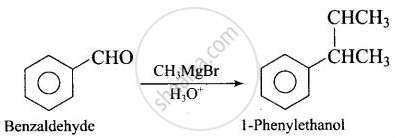Advertisements
Advertisements
प्रश्न
Match the reactions given in Column I with the suitable reagents given in Column II.
| Column I (Reactions) |
Column II (Reagents) |
| (i) Benzophenone Diphenylmethane | (a) \[\ce{LiAlH4}\] |
| (ii) Benzaldehyde 1-Phenylethanol | (b) \[\ce{DIBAL-H}\] |
| (iii) Cyclohexanone Cyclohexanol | (c) \[\ce{Zn(Hg)/Conc. HCl}\] |
| (iv) Phenyl benzoate Benzaldehyde | (d) \[\ce{CH3MgBr}\] |
उत्तर
| Column I (Reactions) |
Column II (Reagents) |
| (i) Benzophenone Diphenylmethane | (c) \[\ce{Zn(Hg)/Conc. HCl}\] |
| (ii) Benzaldehyde 1-Phenylethanol | (d) \[\ce{CH3MgBr}\] |
| (iii) Cyclohexanone Cyclohexanol | (a) \[\ce{LiAlH4}\] |
| (iv) Phenyl benzoate Benzaldehyde | (b) \[\ce{DIBAL-H}\] |
Explanation:
(i)

(ii)

(iii)

(iv)

APPEARS IN
संबंधित प्रश्न
Identify ‘A' and ‘B’ in the following reaction :
C6H5MgBr + C02 `(`> ‘A’ `(PCl_5)/()`> ‘B’
Name the reagents used in the following reactions:

An organic compound (A) (molecular formula C8H16O2) was hydrolysed with dilute sulphuric acid to give a carboxylic acid (B) and an alcohol (C). Oxidation of (C) with chromic acid produced (B). (C) on dehydration gives but-1-ene. Write equations for the reactions involved.
How will you prepare the given compound from benzene? You may use any inorganic reagent and any organic reagent having not more than one carbon atom.
Methyl benzoate
How will you prepare the given compound from benzene? You may use any inorganic reagent and any organic reagent having not more than one carbon atom.
Phenylacetic acid
The functional group present in triacylglycerol is _______.
The reagent which does not react with both, acetone and benzaldehyde.
Which is the most suitable reagent for the following conversion?
\[\begin{array}{cc}
\phantom{....................}\ce{O}\phantom{.....................................}\ce{O}\phantom{.}\\
\phantom{....................}||\phantom{......................................}||\phantom{.}\\
\phantom{}\ce{CH3 - CH = CH - CH2 - C - CH3 -> CH3 - CH = CH - CH2 - C - OH}\phantom{.}
\end{array}\]
Substitution of one alkyl group by replacing hydrogen of primary amines
The end product Y in the sequence of reaction:
\[\ce{RX ->[CN^-] X ->[NaOH] Y}\] is:
